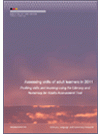This is an initial statistical report on the Literacy and Numeracy for Adults Assessment Tool in terms of the extent of its use in 2011, the first full year of implementation, the reading and numeracy profiles of learners when first assessed, and the extent to which learners can be seen to have increased their reading and numeracy skills over the course of the 2011 year.
Key Results
- In 2011, 77,000 learners were assessed using the Literacy and Numeracy for Adults Assessment Tool, and over 200,000 individual assessments were carried out, across the skills of reading, writing, vocabulary and numeracy.
- More than three quarters of assessments were for reading and numeracy.
- Some of the learners enrolled at each qualification level were assessed, but the focus was on New Zealand Qualification Framework Levels 1 to 4: the percentage of learners assessed in these levels ranged from 16 per cent at Level 4 to 31 per cent at Level 3 (in programmes funded by the Student Achievement Component or Youth Guarantee).
- Youth Guarantee learners were the most thoroughly assessed group, with over 70 per cent assessed at least once, and over 35 per cent assessed at least twice for one or more skills.
- Among learners enrolled in SAC- or YG-funded programmes at NZQF Levels 1 to 3, the rate of assessment was higher among learners enrolled at Institutes of Technology and Polytechnics (36 per cent) than at Private Training Establishments (20 per cent) or at wānanga (15 per cent).
- Assessed learners covered a wide age range, but there was a focus on young learners: 31 per cent of assessed learners were aged 16 to 19 on first assessment in 2011.
- Assessment Tool scores can be converted to Steps on the Tertiary Education Commission’s Learning Progressions for Adult Literacy and Numeracy, which range from lowest skill at Step 1 to highest at Step 6, although there is not a direct correspondence between the Steps for literacy and for numeracy.
- The differences between the Learning Progressions for literacy and for numeracy were reflected in the fact that learners overall were assessed lower on the reading than on the general numeracy steps, with approximately half of learners assessed for reading scoring in the top three steps (Learning Progressions Steps 4, 5 and 6), while for general numeracy approximately half of learners scored in the top two steps (Steps 5 and 6).
- Although the groups of learners assessed using the Assessment Tool were clearly not representative of the adult population, the variations in Assessment Tool reading and general numeracy scores followed the same patterns as the total adult population according to the Adult Literacy and Life Skills (ALL) Survey 2006, in terms of age, gender, ethnicity, first language, and educational participation.
- Among learners assessed at least twice for reading or general numeracy, more than half of those who scored at the bottom of the scale (Step 1) on their first assessment recorded statistically significant gains in skill during 2011. Among others, the rates of significant gain were progressively less the higher their first assessment scores. Learners whose first assessment scores were at the top of the scale (Step 6) had little scope to show significant gain.


